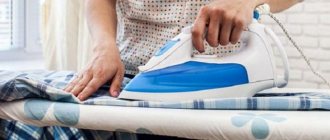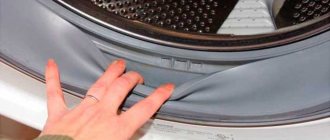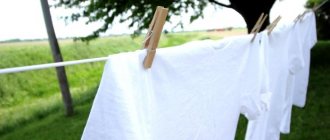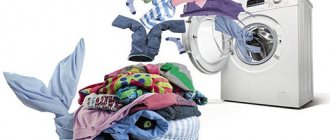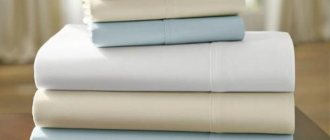Most women in the post-Soviet space are accustomed to carefully ironing their bed linen.
Such conservatism and desire for order were inherited from our grandmothers, who stubbornly boiled, starched, and ironed sheets and duvet covers.
The actions of the ancestors were dictated by hygiene standards. Today ironing is not an urgent need, and many housewives are wondering whether it is necessary to resort to such manipulations.
Why is it not recommended to iron after washing?
Bed linen is ironed for two reasons: disinfection and aesthetics . Smooth sheets and pillowcases, without a single wrinkle, best decorate the bedroom. This effect can only be achieved by ironing the fabric.
A nice bonus to the aesthetic appearance is cleanliness. It's no secret that high temperatures kill most viruses and bacteria.
If a woman does not strive for ultra-cleanliness and an ideal interior, she can afford to give up boring household procedures.
Why can't you iron your bed linen?
There is a logical reason for refusing ironing:
High temperatures destroy fabric fibers. After several washes followed by ironing, the bedding set becomes faded and the colors lose their saturation.- The ironing process has a bad effect on the ability of the fabric to absorb liquid, reducing its hygroscopicity. This fact is most noticeable in the summer months, when after a long sleep you have to dry sheets and pillowcases wet from sweat.
- Not all fabrics require ironing. Materials such as silk, jacquard, calico and boiled cotton practically do not wrinkle. In order to maintain a neat appearance, it is enough to hang them evenly on the dryer immediately after washing, away from direct sunlight.
If the housewife is accustomed to using fabric softener during washing, it is advisable to abandon the use of a classic iron.
The fact is that when heated, particles of household chemicals remaining in the fabric easily enter the air and, with their pungent odor, can cause allergies. In such cases, it is better to iron the washed clothes with steam.
How to iron bed linen correctly
If you decide that bed linen needs to be ironed, this should be done according to all the rules. Ironing most often requires natural, environmentally friendly fabrics - linen, cotton, bamboo, etc. To get it done quickly and efficiently, you need to iron a slightly damp fabric. Pre-spray the overdried product with water and roll it into a roll so that the moisture is evenly distributed throughout the fibers.
Before ironing, make sure that there are no small holes in the sheets and duvet covers, otherwise they will separate under the influence of heat. You should not iron things that have stains on them: after ironing, the stains will penetrate into the structure of the fabric and will be almost impossible to remove.
It is important to choose the right temperature regime for each type of material. Information about care instructions is indicated on the product tag (the same as on clothing). If there is an icon with a crossed out iron, it is strictly forbidden to iron such a thing. The required temperature is indicated by the number of dots inside the image of the iron: the more there are, the more you need to heat the soleplate of the device.
| Material | Heating temperature | Ironing Features |
| Cotton | +180 ℃ | Using a steam generator |
| Chintz | +175 ℃ | On the front side of the product with additional fabric moisture |
| Linen | +200 ℃ | From the wrong side, applying a little force |
| Viscose | +120 ℃ | From the inside out through a piece of cotton or gauze |
| Silk | +80 ℃ | Steam generator in vertical position |
Procedure
It’s most convenient to start the process with the smallest item in the set - pillowcase . Turn it inside out, work the inner curves, then iron it right side out.
The sheet must be folded in length and width so that you get an equilateral rectangle. The fabric needs to be ironed on both sides, then unfolded and done the same with the internal parts. In order for the sheet to look neat, the corners of the product when folded must clearly coincide.
The optimal weight of the iron for ironing bed linen is 1.5 kg.
Ironing a duvet cover is the most time-consuming part of the job. To start, turn it inside out, straighten all the corners and seams on the sides and fasten the opening. Next, fold it in the same way as a sheet and iron each of the four sides, first from the inside and then from the face. In order for the item to become perfectly smooth, it must be processed with effort, and a steam generator must be used more often during the process.
To iron a sheet or duvet cover, fold it in four
After all the products from the kit have been processed, you need to leave them for a while to cool completely. There are two ways to fold laundry in a closet: either sheets, pillowcases and duvet covers separately, or hide all the pieces in a pillowcase and store them as a set.
What do folk signs say?
Every thing in the house has its own energy, the bed especially . A person spends more than 1/3 of his life in it, so there are quite a lot of folk signs associated with bedding.
There is a popular opinion that bedding must be ironed. Regular sleep on crumpled sheets attracts difficulties and failures to a person, darkening his life.
Our ancestors believed that wrinkled linen was the favorite habitat of evil spirits, who sucked energy and vitality out of a person during sleep.
When is ironing not necessary?
People who don't like ironing say that it's a waste of time.
They make the following arguments:
- Ironing is a relic of the past, and the use of an iron was relevant in the last century.
- The ironing process will take a lot of time and effort. Especially if you need to put several sets of laundry in order. This may take hours.
- After ironing, the fabric will only be soft for a few days. Afterwards you will either have to put up with the harshness, or wash and iron it again.
- Certain types of fabric can accumulate static charges . Such materials include synthetics and polycotton.
If your washing machine has an “iron” function, there is no point in using an iron. It is enough to take out the things, hang them on a flat surface, and wait for them to dry completely.
Be careful not to create wrinkles during hanging. Run your palms over the fabric to smooth out any imperfections.
If you wash and dry things regularly using this method, your laundry will last much longer.
In addition, after such manipulations, the underwear will absorb moisture better, and you will not have to wake up in discomfort.
This will also save money on utility bills, since irons and steamers consume a lot of electricity.
If you have linen made of terry fabric, ironing it is not recommended. After this procedure, the fabric will be less pleasant to the body.
If not an iron, then what?
There are many alternative ways to iron laundry. For these purposes, it is not necessary to use a classic iron with a heating surface .
How to make your bedding look neat:
- If, due to the delicate composition of the fabric, it is not possible to iron it, you should use a non-contact method of smoothing the surface using hot steam. This method does not dry out the laundry, as a result of which the made bed will not irritate the skin or become electrified.
- You can also iron things in a washing machine. This is made possible thanks to the easy ironing function. The principle of operation is that the laundry is spun at low drum speeds, as a result of which the fabric does not wrinkle and there are no creases left on it. Items washed in this way do not need to be ironed - just hang them on the clothesline immediately after removing them from the machine.
- Adding fabric softener will soften the fabric fibers and make them more elastic. By hanging it to dry while wet, you can save yourself the ironing process.
Is it possible to put away wet laundry after ironing?
When you finish ironing, you need to leave the even piles for half an hour in a ventilated room. The bed linen should cool and dry. If moisture remains inside and you put it in a closet, after storage it will smell stale, or, worse, mold or mildew will form.
Whether you need to iron bedding sets is up to you to decide; we have listed all the pros and cons. We are for rational use of time and modern ironing methods: proper drying, conditioner and steamer. However, if you really enjoy the process of ironing - it calms you down, brings you closer to your family (or TV), does not take much time, or you have objective reasons - why not? It definitely won't get any worse!
When is this absolutely necessary?
to iron bed linen only in two cases:
- if a person with skin diseases lives in the house;
- if a newborn child appears in the family.
The skin of a newborn baby cannot always withstand an aggressive external environment. This is especially true for the period when the umbilical wound has not completely healed.
At this moment, ironing the baby’s bedding, from a pediatric point of view, is a mandatory procedure. Moreover, it is advisable to iron the fabric both from the outside and from the wrong side .
Heat treatment protects against infection by fungi and bacteria that were found in a sick roommate.
If one of the family members has been diagnosed with scabies, it is necessary to iron not only bedding, but also bath towels.
When you can’t do without using an iron
There are a few exceptions when the procedure is necessary:
- Bedding for children under 3 months of age. Experts strongly recommend that you pay attention to this process, because even the slightest folds in the sheet can seriously injure the baby’s delicate skin.
- People suffering from various skin diseases (lichen, dermatitis or fungus) must have a separate set of bed linen and towels, which must be washed frequently, and then ironed and steamed.
Advice: it is better to discuss the question of whether there is a need to iron a newborn’s linen with a pediatrician.
Yes or no?
There is no exact answer to this question . Each housewife makes a decision based on her own beliefs. However, most European women have given up ironing bed linen.
Of course, an ironed bedding set looks great on the bed. But the neat effect disappears after the first use.
If it is fundamentally important for your family to go to bed in a perfectly ironed bed, you should give preference to products made from wrinkle-resistant fabrics .
Impact on psychological state
Most housewives fanatically iron their clothes for the sake of aesthetics. A perfect, evenly made bed with fresh linens looks like it came straight out of glossy pages; wrinkled duvet covers are not so beautiful.
Those who grew up in families with a fanatical economic mother and grandmother really cannot lie down in unironed linen, perceiving it as stale, as if someone had already slept on the bed.
Psychologists even conducted tests on people with a habit of ironing and regular laundry. It turned out that the former are sensitive to any comments and even react to criticism on the matter inappropriately to the comments. They are too demanding of themselves and exceed their own rights in relation to those around them, re-educating them and demanding to become ideal. As a result, such swells are often left alone for the rest of their lives; it is simply impossible to bear them.
What do they say on the forums?
If we analyze the most popular women's forums that discuss the issue of mandatory ironing, we can conclude that most housewives will part with their iron without hesitation.
This discussion clearly confirms the above. Almost all participants in the discussion answered that they do not iron bed linen, and at the same time do not experience discomfort during sleep.
In their opinion, in order to give the fabric a neat look, it is enough to hang it on a clothesline in a wet state, aligning the corners .
Bed linen that does not need ironing
And if you don’t have time or don’t want to iron your bed, but at the same time you like it when the bed looks neat and attractive, then the best option is wrinkle-resistant sets. They are made from 100% bamboo fiber and can maintain their original appearance for up to 500 washes. You can purchase them in our store: The product is always in stock. We have convenient delivery methods and regular promotions!
Now you know whether it is necessary to iron bedding sets after finishing washing. Everyone makes the final decision for themselves, but the most important thing is that you feel comfortable and comfortable while sleeping.
How to bleach bed linen
Bleach is used to effectively remove dirt and stains. They activate oxidative processes and dissolve dirt that is washed off during the washing process. Some bleaches, in addition to brightening and refreshing fabric, also disinfect it.
For home use, two types of products are known: chlorine and oxygen.
chlorine based
Sodium hypochlorite solution is considered the most powerful product with a bleaching and disinfecting effect, which is produced in liquid and dry form. Both types require further dilution with water.
Chlorine bleach affects almost all natural products, such as cotton. To use it effectively, it must be added in the right amount at the right time. The temperature must be selected individually.
Stir the bleach well before adding it to the washing machine. Do not pour liquid directly onto the fabric. This threatens complete loss of color of the treated area and damage to the fibers. The product with any stains present on it is bleached entirely.
oxygen based
Oxygen bleach is suitable for most fabrics, including colored ones, so it is considered universal. However, its use on silk, wool and leather products is not allowed.
The product works less actively than in a situation with chlorine, but the existing qualities are sufficient to eliminate bacteria and give the bed linen the proper appearance.
The powder form is considered the most practical. The liquid analogue loses its effectiveness over time. You should take warm water, add the powder to it, wait for complete dissolution and, if necessary, add cold water to the desired volume. Then immerse the laundry in water and wait for the time specified in the instructions. The more it is exposed to oxygen bleach, the better the result.
In our articles, we talk a lot about how and what to store clothes, how to decide to declutter, how to learn to buy “wisely”, without giving in to momentary impulses. But the fact remains: our generation has a huge amount of clothes.
For us, it's normal to wear a fresh set every day. This means that you have to wash things, a lot and often. After washing - dry. When dry, iron. This is a whole technological process that requires soaking basins, a washing machine, detergents, a dryer, an iron and an ironing board - the minimum set of a modern housewife.
I'll start with the boring pictures of ideal home laundries: separate rooms in the house that have everything for caring for clothes.
At the very least, it is heartless to show them to many Russian housewives. Our living spaces only allow us to fit a washing machine into the corner of the kitchen or bathroom. The drying rack and ironing board, when folded, huddle in the corners, and when unfolded, they occupy most of the space of the apartment.
For example, now I live in an old “Stalinist” house, in a large apartment with high pretentious ceilings, stucco molding and huge windows. With all this, there is absolutely no room in the house for solving “household” issues. Even the narrowest washing machine cannot fit in the tiny bathroom, and there is no balcony where you can dry clothes. Thank you - there is a small storage room where the ironing board is hidden.
My washing machine sits in the kitchen, taking up precious storage space for kitchen utensils. The laundry basket is in a different place. The dryer is at the opposite end of the apartment. The board is in third place, the iron is in fourth. I wash my clothes in the bathroom. Clothes care equipment is scattered throughout the apartment, and it can be infuriating at times!
I definitely decided that the first room that I would plan in my apartment under construction would be a laundry room. It doesn’t have to be a separate room - perhaps just a small corner or “nook” in which you can find everything for washing, drying and ironing clothes. In the meantime, all that remains is to collect ideas and analyze other people's experiences.
Laundry cycle
Some time ago, while learning the Fly Lady system, the phrase “linen cycle” appeared in my dictionary. Our trainer instructed us to create a clothing and linen care schedule that would include: • machine washing, • hand washing delicate items, • hanging to dry, • ironing, • changing bed linen and towels, • clothing repair, • optimization (assessment quantity of clothing, its condition, relevance, working with seasonal clothing, organizing storage), • day off - a day when we do not do any of the above.
In one or two weeks, after assessing the amount of dirty clothes that appeared, I was able to create my own schedule: • every day except Saturday, 1-2 washes in the machine, I hang them on the dryer, take off and put in places what is dry, • on Mondays I iron my husband’s shirts, • I put off hand washing until Wednesday, • on Thursdays – optimization work (if necessary), • on Friday – changing bed linen and towels, • Saturday – day off, • Sunday – repairing clothes to the accompaniment of an interesting film or TV series.
It seems that creating a laundry cycle schedule is a waste of time, and it is clear that all of the above needs to be done and is usually done. But, believe me, for such disorganized people as I was some time ago, having a schedule is a necessary disciplinary moment. He doesn’t allow anyone to be cowardly, putting off doing laundry until the weekend, when there seems to be more time than on weekdays. As a result, most often the weekend is full of other interesting things to do, and on Monday you stand in front of an empty closet and realize that nothing is clean.
We collect and sort dirty laundry
I turned to my colleagues from “Everything is in Place”, and they sent me photos of their baskets (as well as cars and dryers, so this article is completely illustrated by them :).
Many people, like me, collect dirty laundry in one container and sort it immediately before washing. Containers are most often located closer to the washing machine, even if it is installed in the kitchen (and this often happens in our homes).
What can I say - Ikea rules! The three photos below show IKEA laundry baskets.
But plastic containers and baskets from a regular hardware store also do their job well. The volume depends on your needs. It is convenient when the container for dirty laundry has a lid, then guests will not become unwitting witnesses to its contents.
It’s even cooler when you have the opportunity to immediately sort dirty laundry. Pay attention to the photo - it is not from the Internet, this is a real washing and cleaning corner of Yulia, a member of the “Everything is in Place” team. On the left is the Ikea system of wire baskets, into which dirty clothes are immediately laid out according to the type of washing. Everything is great here - organized storage of detergents and washing powder, and space for cleaning equipment.
And a few more ideas on how to organize the storage of dirty laundry.
We erase
The washing machine is the greatest invention of civilization. I speak as a person who does laundry every day for five people, two of whom are preschool children. In such conditions, a washing machine is not a luxury, but a military tactical weapon. I won’t write about choosing a machine, since there are thousands of them in stores, and this is a matter for specialized sites. But where to put it, to put the powders - this is our topic.
Mine is in the kitchen, fitted under the kitchen unit, because it wouldn’t fit in the bathroom.
After interviewing girls, I realized that this is the case for many. At the same time, the niche for the typewriter often has a door so that it can be hidden. Some noted that this is inconvenient, since after washing the machine needs to be dried - open the compartment for washing powder and the door of the device. You have to open the cabinet and leave it like that.
In my value system, a washing machine in the bathroom is a blessing! Here you can wash it, soak it in a basin and then immediately transfer it to the drum. No washing powders in the kitchen, near dishes and food.
The only negative - I often see this in the houses of friends - if in the bathroom (and in any other room) the washing machine is not hidden under the countertop or in a special closet, it usually accumulates a warehouse of things: toilet paper, bottles, washing powders, children's supplies and toys, dirty laundry... The solution is simple - declutter (check expiration dates of cosmetics, serviceability of toys, put things back in place) and organize (baskets,
boxes, organizers for
cosmetics and small items , special containers for washing powder , laundry baskets, mobile shelves ). Find ideas on how to relieve the surface of the washing machine and organize storage even in a small bathroom.
If you buy washing powders in large quantities, then pay attention to washing powder containers . They help to refine the “laundry” area, prevent the powder from crumbling, as often happens with packaging bags, and protect it from moisture.
Drying
Hanging out laundry is a routine process. You can’t live without it, which is why today there are many devices for drying laundry.
I'll start by praising my dryer. If you see one in a store, buy it without hesitation! It is compact both folded and unfolded. Very roomy - it can accommodate two large washes (my machine is designed for 7 kg of laundry and I try to load it to capacity). In the photo it is unfolded halfway. An ideal solution for small apartments!
A very common type of dryer is books. I also have this one, but I don’t like it because it takes up too much space. But it’s roomy and it’s more convenient to dry bed linen on it.
It's great to have a place to store a folded dryer. But in our homes there is often no special place for them, so where they stand is fine. But this is the norm, everyone is used to it.
“Balcony” dryers are common. Their advantage is that they do not take up space in the apartment and are spacious. They can also be used indoors.
There are many more options: mini dryers that hang on a heating radiator, just a radiator, a heated towel rail, doors and chairs - I have never seen any methods. My relative dries her children's outdoor clothes directly on the heated bathroom floor. But you must admit that when clothes dry to the side, without taking up space or becoming an eyesore, it’s much more pleasant.
Washing machines with a drying function or special drying machines are a separate story. Beautiful pictures from the Internet often show laundry areas with just two machines – a washing machine and a dryer. But with our premises we have to choose washing machines with a drying function. Those who have them praise them very much. But with a caveat - often the laundry has to be dried, so a regular dryer is also needed in everyday life. I have experience using this type of machine and I can say that it is ideal for wet areas or conditions.
Here are some more ideas from the Internet about what types of dryers there are.
Ironing
Ironing is a scary word for me. As best I could, I reduced the amount of laundry I ironed weekly, leaving only my husband’s shirts. T-shirts, turtlenecks, trousers and jeans, bed linen (and even more so underpants and socks) - I don’t iron anything, and I’ve gotten over my complex about it. “Life can be spent on something more interesting!” - said my colleague Maria, and I completely agree with her. I shake everything that I have prepared for drying thoroughly and hang it out, straightening and smoothing out all the wrinkles. In most cases, this is enough to make the clothes look good. A nuance - the quality of spinning clothes in the machine also affects the appearance of the clothes. I set the spin speed to no more than 800. If it’s higher, the laundry turns out “chewed” and no amount of careful hanging will help, you’ll have to iron it.
A little life hack from my colleague Alena: iron only the seams and corners of bed linen - this makes the folding process easier and does not take much time.
Have you heard about the “wet” ironing method? I first learned about it at a training session on the Fly Lady system. The trainer suggested that after washing, we should not hang up our laundry immediately, but carefully lay them on top of each other on a flat surface without folds or creases and leave them for half an hour. After this, hang to dry as usual. Dry laundry will feel as if it has been ironed. I tried it and the result is visible - not the same as after ironing, but still. The only disadvantage of this method is that it requires additional actions that take time.
Where do dry, clean clothes go from the dryer before being ironed? For many people it’s on an ironing board, for others it’s in a closet, and they iron it as needed. Another proposed method is a special container for unironed laundry. But for me personally, this is a dead-end path, since everything that ends up in such a container will lie there, instead of ending up on the right shelves.
Well, storage of the ironing board. I looked at my colleague Elena’s storage method for the future. She spoke in general about the organization of the laundry room in her house: “I have a laundry corner in the bathroom - there is a washing machine here. Recently, I finally came up with a beautiful and convenient way to store and sort laundry - these are two large drawers next to the washing machine. We put dirty laundry in the bottom one - the drawer is large, and before washing it is convenient to sort it into whites/colors. The top drawer is for clean things. Then they can be ironed or used immediately (for example, terry towels and bath sheets). Right there in the bathroom there is a built-in wardrobe, there is a large compartment below for water distribution, and the ironing board fits perfectly here in height (I also store a basin, a vacuum cleaner and a mop there). And on the shelves above are powder and washing chemicals, as well as an iron.”
And several ways to organize a place for ironing and storing an ironing board from the Internet.
By the way, how do you feel about built-in ironing boards? Is it convenient when the board is fixed in one place? I suggest discussing this in our groups VKontakte , Facebook and Instagram!
That's it, I'm finishing! Although any woman can tell so much about washing that it would be enough for a whole book. Once again I invite you to our groups on social networks - live communication, useful tips and unique products. Waiting for you!
How to fold bed linen
When it comes to care, storing bed linen plays an important role. To keep your accessories compact and not take up a lot of space in your closet and chest of drawers, you should learn some recommendations:
- ironing textiles after washing makes the laundry convenient for storage;
- natural fabrics, unlike synthetics, “shrink” better;
- It is advisable to fold versions of duvet covers with a window in the middle with the hole inward;
- if the sheets have elastic, the easiest way is to put the corners on top of each other and wrap them inward;
- the inner pocket on the pillowcase is adjusted (the exception is the presence of a zipper);
- placing each element of the kit in a separate stack helps to use space wisely;
- Many housewives put the entire set in a pillowcase, which simplifies storage organization.
Caring for bed linen is a necessary matter, because it concerns a person’s individual comfort. Compliance with the recommendations described above will allow the product to retain its presentation for a long time, provide a lot of aesthetic pleasure, and most importantly, ensure the cleanliness and comfort of the sleeping area.
Disadvantages of ironing
However, this procedure also has some disadvantages:
- after ironing, the pleasant smell of the laundry is lost, especially the smell of frost;
- this procedure takes a lot of time, and with the modern rhythm of life it can be problematic to allocate an extra half hour for ironing bedding;
- a number of materials are easily electrified upon contact with an iron;
- The iron consumes a significant amount of electricity.
In some cases, you can give the sheets a neat and tidy look without ironing. To do this, it is enough to hang the sheets during drying so that creases and folds do not form on the fabric.
